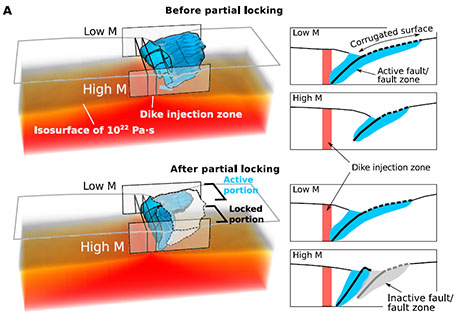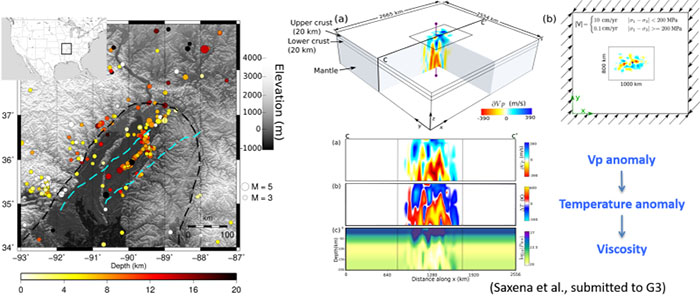Geodynamics
Geodynamics Research Group at CERI aims to understand how geological structures in crust and lithosphere form and evolve through numerical simulations. Furthermore, collaborating with other colleagues at CERI, we are also studying why earthquakes occur in regions far from plate boundaries such as the New Madrid Seismic Zone, the Charlesvoix Seismic Zone and the Korean peninsula. To facilitate our research, we develop or adopt various simulation codes that are most suitable for our purposes. We continue to improve the simulation code we developed in terms of functionality and performance by adopting advanced numerical techniques and recent developments in high-performance computing.
 Variations in faulting styles at mid-ocean ridges
Variations in faulting styles at mid-ocean ridges
The main goal of this project is to understand how magmatic processes at the spreading center of mid-ocean ridge can determine faulting styles that are variable along the ridge axis. A novel aspect of the project is to include explicitly the along-axis variability in magmatic activity.
To see some numerical models in action, please go to the project's Figshare page. We are trying to extend spatial and temporal scales of these models to explore a longer portion of oceanic lithospehre's lifespan, from birth at mid-ocean ridge to subduction.
Sources of Stress in Intraplate Seismic Zones

We compute stresses generated by crustal and mantle heterogeneities imaged seismologically. Known plate motions or other factors, whenever available, are also taken into account. The resultant stress field can guide us in reasoning the origin of earthquakes occurring in apparently "stable" regions, mostly far from active plate margins. This research will continue to evolve as more and newer data become available: e.g., Higher-resolution seismic tomography, improved constraints on crustal and lithospheric thickness, geological reconstruction, or history of changes in surface loading.
DES3D, a Geodynamic Simulation Code
We have developed a novel simulation code, DES3D (Dynamic Earth Solver in 3D), in collaboration with a group of international researchers. DES3D is a fast and robust geodynamic code incorporating some of the latest advances in computational solid mechanics such as nodal mixed discretization on an unstructured mesh and adaptive mesh refinement. It accelerates on GPU using NVidia's CUDA technology enabling high-resolution three-dimensional models as shown in this YouTube video.
Tectonic-Surface Process Coupling
This research aims to model the interplay between tectonic and surface processes through software coupling. As a preliminary work, we have successfully coupled SNAC and CHILD. SNAC is a tectonic modeling code and CHILD is a surface process modeling code. The coupled codes produced interesting results for a compressional and an extensional environment. We are now trying to couple DES3D with a surface processing code to continue our efforts to understand how the surface processes like erosion and deposition influence long-term tectonic processes and vice versa.
Overview of Research Interests
In summary, the research interests of faculty affiliated with Geodynamics include:
- Seismotectonics
- Mantle and lithospheric heterogeneities and their effects on stress field
- Bridging interseismic inelastic deformations and co-seismic frictional behavior
- On- and off-fault effects of roughness
- Large-offset normal faults in extensional tectonic settings
- Faulting styles at mid-ocean ridges and the life cycle of oceanic lithosphere
- Large-offset normal faults in extending continental crust
- Thermo-mechanical coupling including effects of thermal expansion and contraction
- Coupling tectonic and surface processes
- Application of advanced numerical techniques and recent developments in high-performance computing
Members of Geodynamics Research Group
Current graduate students:
- Zohreh Abbasi Hafshejani
- Ryann C. Lam
- Hao Lu
Past graduate students:
- Oluwaseun Fadugba
- Arushi Saxena
- Yang Yang, Ph.D.
- Hee Choi, M.Sc.
- Khurram Aslam, Ph.D.
- Demian Gomez, Ph.D.
- Xiaochuan Tian, M.Sc.
- Lian Feng, M.Sc.
- Md. Sabber Ahamed, Ph.D.
